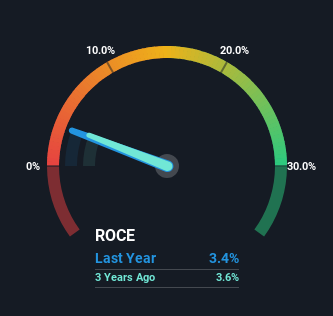- South Korea
- /
- Electronic Equipment and Components
- /
- KOSDAQ:A203450
Here's What's Concerning About Union Community's (KOSDAQ:203450) Returns On Capital
When we're researching a company, it's sometimes hard to find the warning signs, but there are some financial metrics that can help spot trouble early. More often than not, we'll see a declining return on capital employed (ROCE) and a declining amount of capital employed. Trends like this ultimately mean the business is reducing its investments and also earning less on what it has invested. And from a first read, things don't look too good at Union Community (KOSDAQ:203450), so let's see why.
Understanding Return On Capital Employed (ROCE)
For those that aren't sure what ROCE is, it measures the amount of pre-tax profits a company can generate from the capital employed in its business. Analysts use this formula to calculate it for Union Community:
Return on Capital Employed = Earnings Before Interest and Tax (EBIT) ÷ (Total Assets - Current Liabilities)
0.034 = ₩1.5b ÷ (₩59b - ₩16b) (Based on the trailing twelve months to June 2024).
So, Union Community has an ROCE of 3.4%. In absolute terms, that's a low return and it also under-performs the Electronic industry average of 6.9%.
Check out our latest analysis for Union Community

Historical performance is a great place to start when researching a stock so above you can see the gauge for Union Community's ROCE against it's prior returns. If you're interested in investigating Union Community's past further, check out this free graph covering Union Community's past earnings, revenue and cash flow.
What Can We Tell From Union Community's ROCE Trend?
In terms of Union Community's historical ROCE movements, the trend doesn't inspire confidence. About five years ago, returns on capital were 9.7%, however they're now substantially lower than that as we saw above. On top of that, it's worth noting that the amount of capital employed within the business has remained relatively steady. Since returns are falling and the business has the same amount of assets employed, this can suggest it's a mature business that hasn't had much growth in the last five years. If these trends continue, we wouldn't expect Union Community to turn into a multi-bagger.
The Bottom Line On Union Community's ROCE
In summary, it's unfortunate that Union Community is generating lower returns from the same amount of capital. Investors must expect better things on the horizon though because the stock has risen 11% in the last five years. Either way, we aren't huge fans of the current trends and so with that we think you might find better investments elsewhere.
If you want to know some of the risks facing Union Community we've found 5 warning signs (1 is potentially serious!) that you should be aware of before investing here.
While Union Community may not currently earn the highest returns, we've compiled a list of companies that currently earn more than 25% return on equity. Check out this free list here.
New: AI Stock Screener & Alerts
Our new AI Stock Screener scans the market every day to uncover opportunities.
• Dividend Powerhouses (3%+ Yield)
• Undervalued Small Caps with Insider Buying
• High growth Tech and AI Companies
Or build your own from over 50 metrics.
Have feedback on this article? Concerned about the content? Get in touch with us directly. Alternatively, email editorial-team (at) simplywallst.com.
This article by Simply Wall St is general in nature. We provide commentary based on historical data and analyst forecasts only using an unbiased methodology and our articles are not intended to be financial advice. It does not constitute a recommendation to buy or sell any stock, and does not take account of your objectives, or your financial situation. We aim to bring you long-term focused analysis driven by fundamental data. Note that our analysis may not factor in the latest price-sensitive company announcements or qualitative material. Simply Wall St has no position in any stocks mentioned.
About KOSDAQ:A203450
UNION biometrics
Provides various biometric solutions in South Korea and internationally.
Flawless balance sheet with solid track record.
Market Insights
Weekly Picks

Solutions by stc: 34% Upside in Saudi's Digital Transformation Leader


The AI Infrastructure Giant Grows Into Its Valuation
Recently Updated Narratives

Perdana Petroleum Berhad is a Zombie Business with a 27.34% Profit Margin and inflation adjusted revenue Business
Many trends acting at the same time


Engineered for Stability. Positioned for Growth.
Popular Narratives


MicroVision will explode future revenue by 380.37% with a vision towards success


NVDA: Expanding AI Demand Will Drive Major Data Center Investments Through 2026



